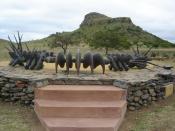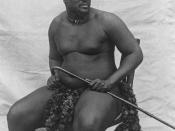Isandlwana, in Zulu, means "something like a little house." The spur sits on a gradually rising plain approximately 10 mi (16 km) from Rorke's Drift. Because of poor roads and the unwieldy wagons, it took Lord Chelmsford 10 days to make the passage from Rorke's Drift to the foot of Isandlwana, where he arrived on 20 January 1879. Since Chelmsford's plan was for a quick strike toward the Zulu Royal Kraal at Ulundi, he considered his camp temporary, and did not follow the advice of Paul Kruger and other Boers to form a wagon-laager, a standard Boer tactic when fighting against the Zulus. He also did not follow his own November Field Force Regulations which called for a partial entrenchments.
On 21 January, Chelmsford sent out patrols to try to locate the main Zulu impi. Maj. Charles Dartnell, that afternoon, reported an encounter with a large Zulu force. On 22 January, responding to Dartnell's report, Chelmsford split his main force and accompanied an additional 1600 troops to support those already in the field, leaving approximately 1800 men, including the 24th Warwickshires, to guard the camp.
The main Zulu impi, consisting of about 20000 troops divided into three corps under the commands of Ntshingwayo kaMahole, Mavumengwana kaNdlela, and Dabulamanzi kaMpande had left Ulundi on 17 January and, on 20 January were camped about 15 mi (25 km) from Isandlwana. Using Shaka kaSenzangakhona's "horns and chest" maneuver, they attacked the British main camp at about noon on 22 January. The superior firepower of the British Martini-Henry .45 cal breechloading rifles initially checked the Zulus who were armed with throwing spears (assegais), short, stabbing spears (iKlawa), oxhide shields (isiHlangu), war clubs (iWisa), and approximately 15000 assorted rifles in various calibres. Eventually the overwhelming numbers and bravery of the Zulus, coupled with...


